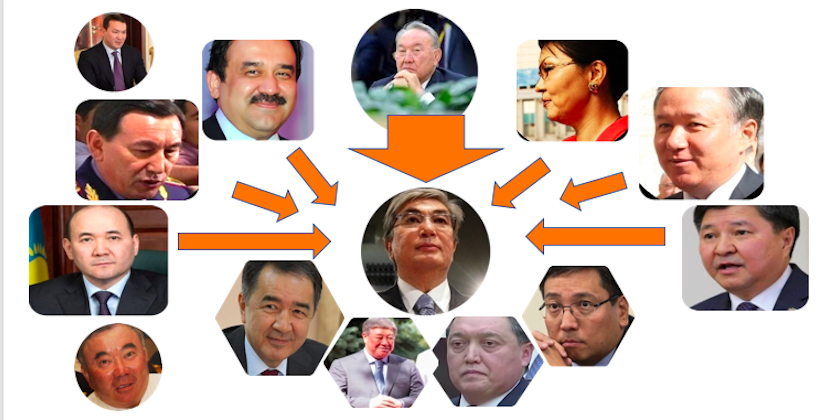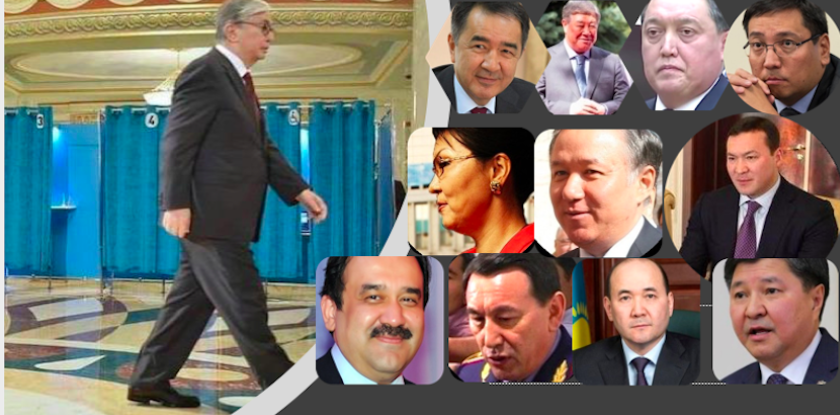Kazakhstan’s presidential elections have ended with a predictable result – appointed by Nursultan Nazarbayev, Kasym-Zhomart Tokayev has become the First President’s successor put in charge of the state. So, now we can see clearly what the configuration of the authoritarian political system and the super-presidential power vertical looks like.
The First President Nursultan Nazarbayev who is still omnipotent and can do whatever he wants albeit not holding any responsibility and not having well-defined powers is obviously on the top.
Second President of the Republic of Kazakhstan comes next. He, although officially holding the power and all the authorities that do not differ greatly from those of his predecessor, is much weaker than Nazarbayev as a political actor. With that, he is doomed to act not in the way he and his circle want but in the way that the First President and his entourage find desirable. He is doomed because Nursultan Nazarbayev has foreseen and skillfully mastered everything.
Below and on the sides of the second President, there are Prime Minister Askar Mamin, Head of the Presidential Administration Bakytzhan Sagintayev, Chairman of the National Bank Erbolat Dosayev and Chairman of the National Welfare Fund Samruk-Kazyna Akhmetzhan Esimov.
All of them are Nursultan Nazarbayev’s henchmen, all of them are experienced, know the rules of the game excellently and adhere to them zealously. The likelihood of their taking the side of the new President in the event of the latter’s direct confrontation with the Leader of the Nation equals zero.
The rest of the officials whom Tokayev has been allowed to appoint himself (such as the Head of the Government Chancellery, Press-Secretary or the Head of the Department of Presidential Affairs) do not play a significant role in the country’s domestic policy. Thus, the current head of the state has been surrounded. And his situation is especially precarious since, behind the first circle of the four actors who have surrounded him, there is a second and even a third one.
The second circle consists of Heads of the Senate and the Mazhilis (Lower House) of the Kazakh Parliament Dariga Nazarbayeva and Nurlan Nigmatullin, Secretary of Security Council Kalmukhanbet Kasymov, Prosecutor General Gizat Nurdauletov, Chief of the National Security Committee Karim Masimov, Chief Justice Zhakip Asanov. Obviously, all these high-rank officials will take Nazarbayev’s side in the event of his conflict with Tokayev. With that, all of them possess some kind of tool or channel to exert pressure on Kazakhstan’s second President.
The third circle consists of the Leader of the Nation’s relatives and allies. Their task is the monitoring of not only their own bosses (this is the task for, say, First Deputy Chief of the National Security Committee Samat Abish or member of the Supreme Court Meyrambek Taymerdenov) but of Tokayev and his entourage.
Therefore, the second President of the Republic of Kazakhstan is destined to be honest, hard-working and loyal. He has no other option. Nor does he have at his disposal any life-saving appliances such as immunity from prosecution, a billion-dollar fortune and a lot of allies.

Does Kasym-Zhomart Tokayev realize this? Undoubtedly.
Moreover, Nursultan Nazarbayev, by the force of his habit to hedge the bets more than one time, has probably warned Tokayev that he may personally take the latter to court at any given moment.
There is, however, one factor that is beyond anyone’s control even that of the omnipotent dictator – time. If Nazarbayev suddenly passes or becomes incapacitated, the situation will change in an instance. And then, from a beggar, Tokayev may turn into a prince.
Obviously, this is not a guarantee since, in the event of the Leader of the Nation’s death, everyone with any kind of political weight, ambitions and a possibility to play will immediately join the game. But, if Nazarbayev, having significantly lowered his current workload, lives for another several years, the likelihood of Tokayev becoming an electable candidate at the next presidential elections rises dramatically.
And then, the configuration of the authoritarian political system and the super-presidential power vertical created in a matter of days literally in front of our own eyes will continue to exist and become more stable. Especially given the fact that it is but a modernization of its old version based on the new conditions and challenges. In other words, it has been tested and has confirmed its sustainability and effectiveness.
We will even predict that such a configuration of the authoritarian political system and the super-presidential power vertical may exist in Kazakhstan for the next couple of decades. With that, the name of the third and so on leader of the Kazakh state, their personal traits, talents and abilities will come secondary to it.
It looks like the main “architect” of the said configuration wants to preserve the proverbial internal political stability while keeping supreme power in the hands of the country’s most important family, in other words, in the hands of Nursultan Nazarbayev’s children, grandchildren and other relatives and letting them choose the next head of the state. In our opinion, this is the main design and the end-goal of Kazakhstan’s First President.
The only problem is that the conservation of the authoritarian political system and the super-presidential vertical have already turned into the greatest danger for the country’s future. And the most frightening thing is that the political stagnation accompanied by the economic one may convert into a threat to the state’s and the Kazakh people’s very existence.




